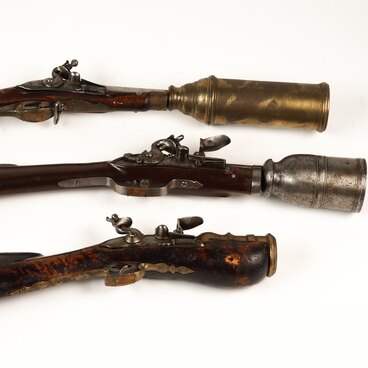Together with the tsardom, Peter I inherited 2,700 artillery pieces: mortars, howitzers and cannons, which, however, did not ensure victory in the Battle of Narva in 1700.
By this time, the technology of gun manufacturing had reached great heights, many cannons were structurally close to the 19th–century guns with horizontal and vertical sliding action. Since the 16th century, gun manufacturers knew that the range of the shot was correlated with the length of the barrel, and saw the importance of rifling inside the barrels. Explosive shells were used. By the turn of the 17th century, attempts were made to combine several barrels and thereby increase the rate of fire (such weapons were called “organ” or “magpie” guns).
Mortars were used primarily as siege artillery guns. They fired at high elevation angles, approximately like modern mortars. Thanks to this, their shells could fly over ramparts, fortress walls and other shelters and hit the enemy hiding behind them.
In the 17th–18th centuries, these guns were divided into “sitting” and “hanging”. A distinctive feature of the former was a flat pallet on the breech, on which a mortar was installed. It was cast together with the barrel. For the “hanging” mortars, special mortar mounts were used to install the gun.
The presented mortar of 1701 is a “sitting” siege mortar, that is, it is mounted on a pallet. In the 16th–18th centuries, such guns fired projectiles along a steep trajectory.
In the 16th century mortars fired gunstones, since the 17th century — explosive shells (hollow cast-iron balls that were filled with gunpowder).
This mortar was made by Semyon Leontiev, an outstanding Russian master of casting, a student of master Martian Osipov of the Moscow Cannon Court. In 1699, he was transferred to become a gunsmith, by 1720 he was listed as the leading founder of the St. Petersburg Arsenal, and in 1726 — as “commissar of copper affairs”. Leontiev became famous for many of his cast cannons, mortars and bells. In 1732, he took part in casting of the “copper persona” of Empress Anna Ioannovna (a statue).
By this time, the technology of gun manufacturing had reached great heights, many cannons were structurally close to the 19th–century guns with horizontal and vertical sliding action. Since the 16th century, gun manufacturers knew that the range of the shot was correlated with the length of the barrel, and saw the importance of rifling inside the barrels. Explosive shells were used. By the turn of the 17th century, attempts were made to combine several barrels and thereby increase the rate of fire (such weapons were called “organ” or “magpie” guns).
Mortars were used primarily as siege artillery guns. They fired at high elevation angles, approximately like modern mortars. Thanks to this, their shells could fly over ramparts, fortress walls and other shelters and hit the enemy hiding behind them.
In the 17th–18th centuries, these guns were divided into “sitting” and “hanging”. A distinctive feature of the former was a flat pallet on the breech, on which a mortar was installed. It was cast together with the barrel. For the “hanging” mortars, special mortar mounts were used to install the gun.
The presented mortar of 1701 is a “sitting” siege mortar, that is, it is mounted on a pallet. In the 16th–18th centuries, such guns fired projectiles along a steep trajectory.
In the 16th century mortars fired gunstones, since the 17th century — explosive shells (hollow cast-iron balls that were filled with gunpowder).
This mortar was made by Semyon Leontiev, an outstanding Russian master of casting, a student of master Martian Osipov of the Moscow Cannon Court. In 1699, he was transferred to become a gunsmith, by 1720 he was listed as the leading founder of the St. Petersburg Arsenal, and in 1726 — as “commissar of copper affairs”. Leontiev became famous for many of his cast cannons, mortars and bells. In 1732, he took part in casting of the “copper persona” of Empress Anna Ioannovna (a statue).





